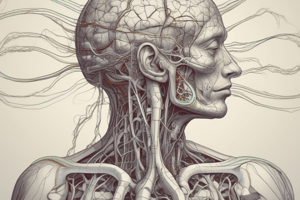Podcast
Questions and Answers
What percentage of the total cardiac output does the brain receive?
What percentage of the total cardiac output does the brain receive?
- 15-20% (correct)
- 5-10%
- 25-30%
- 35-40%
Which of the following arteries is NOT a main artery that supplies blood to the brain?
Which of the following arteries is NOT a main artery that supplies blood to the brain?
- Posterior cerebral artery (PCA)
- Middle cerebral artery (MCA)
- Posterior inferior cerebellar artery (PICA) (correct)
- Anterior cerebral artery (ACA)
What is the primary function of autoregulation in cerebral blood flow?
What is the primary function of autoregulation in cerebral blood flow?
- To reduce blood flow in response to changes in glucose levels
- To maintain a constant blood flow despite changes in blood pressure (correct)
- To increase blood flow in response to neural activity
- To regulate blood flow in response to changes in oxygen levels
What type of blood vessels are responsible for exchanging oxygen and nutrients with the brain?
What type of blood vessels are responsible for exchanging oxygen and nutrients with the brain?
What is the primary function of the blood-brain barrier?
What is the primary function of the blood-brain barrier?
What is an example of a disorder affecting cerebral circulation?
What is an example of a disorder affecting cerebral circulation?
What is the name of the inflammation of cerebral blood vessels?
What is the name of the inflammation of cerebral blood vessels?
What is the name of the constriction of cerebral arteries?
What is the name of the constriction of cerebral arteries?
Flashcards are hidden until you start studying
Study Notes
Cerebral Circulation Overview
- The cerebral circulation refers to the blood flow to and from the brain.
- It is a vital process that supplies oxygen and nutrients to the brain and removes waste products.
Blood Supply to the Brain
- The brain receives 15-20% of the total cardiac output, despite accounting for only 2% of the body's weight.
- The two main arteries that supply blood to the brain are:
- Anterior cerebral artery (ACA)
- Middle cerebral artery (MCA)
- Posterior cerebral artery (PCA)
- These arteries branch into smaller arterioles and eventually into capillaries, where oxygen and nutrients are exchanged.
Cerebral Blood Flow Regulation
- Cerebral blood flow is regulated by:
- Autoregulation: the brain's ability to maintain a constant blood flow despite changes in blood pressure.
- Neurogenic regulation: the brain's ability to regulate blood flow in response to neural activity.
- Metabolic regulation: the brain's ability to regulate blood flow in response to changes in oxygen and glucose levels.
Cerebral Vasculature
- The cerebral vasculature is composed of:
- Arterioles: small arteries that branch into capillaries.
- Capillaries: thin-walled vessels where oxygen and nutrients are exchanged.
- Venules: small veins that merge into larger veins.
- Cerebral veins: veins that drain blood from the brain.
Blood-Brain Barrier (BBB)
- The BBB is a specialized barrier that separates the brain from the bloodstream.
- It is composed of:
- Endothelial cells
- Basement membrane
- Pericytes
- Astrocytes
- The BBB regulates the passage of substances into and out of the brain.
Cerebral Circulation Disorders
- Disorders affecting cerebral circulation include:
- Ischemic stroke: reduced blood flow to the brain.
- Hemorrhagic stroke: bleeding in the brain.
- Vasospasm: constriction of cerebral arteries.
- Cerebral vasculitis: inflammation of cerebral blood vessels.
Cerebral Circulation Overview
- Cerebral circulation is the blood flow to and from the brain, supplying oxygen and nutrients and removing waste products.
- It is a vital process that accounts for 15-20% of the total cardiac output, despite the brain only making up 2% of the body's weight.
Blood Supply to the Brain
- The brain receives blood from two main arteries: anterior cerebral artery (ACA), middle cerebral artery (MCA), and posterior cerebral artery (PCA).
- These arteries branch into smaller arterioles and eventually into capillaries, where oxygen and nutrients are exchanged.
Cerebral Blood Flow Regulation
- Cerebral blood flow is regulated by autoregulation, which maintains a constant blood flow despite changes in blood pressure.
- Neurogenic regulation allows the brain to regulate blood flow in response to neural activity.
- Metabolic regulation allows the brain to regulate blood flow in response to changes in oxygen and glucose levels.
Cerebral Vasculature
- The cerebral vasculature is composed of arterioles, capillaries, venules, and cerebral veins.
- Arterioles are small arteries that branch into capillaries.
- Capillaries are thin-walled vessels where oxygen and nutrients are exchanged.
- Venules are small veins that merge into larger veins.
- Cerebral veins drain blood from the brain.
Blood-Brain Barrier (BBB)
- The BBB is a specialized barrier that separates the brain from the bloodstream.
- It is composed of endothelial cells, basement membrane, pericytes, and astrocytes.
- The BBB regulates the passage of substances into and out of the brain.
Cerebral Circulation Disorders
- Ischemic stroke occurs when there is a reduced blood flow to the brain.
- Hemorrhagic stroke occurs when there is bleeding in the brain.
- Vasospasm is the constriction of cerebral arteries.
- Cerebral vasculitis is the inflammation of cerebral blood vessels.
Studying That Suits You
Use AI to generate personalized quizzes and flashcards to suit your learning preferences.




